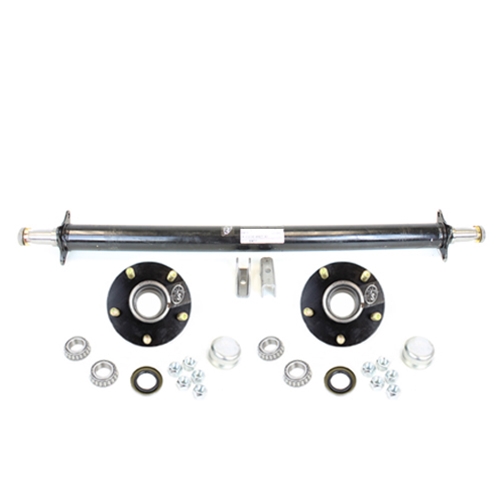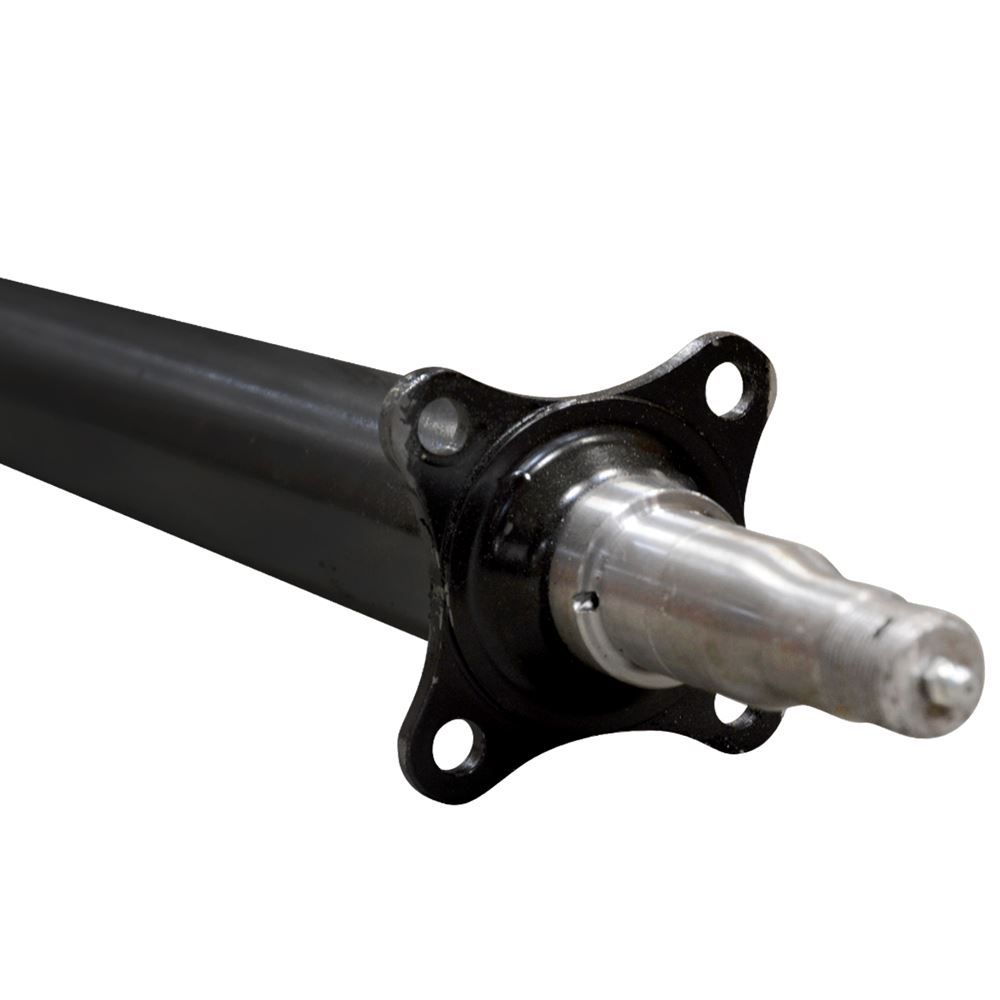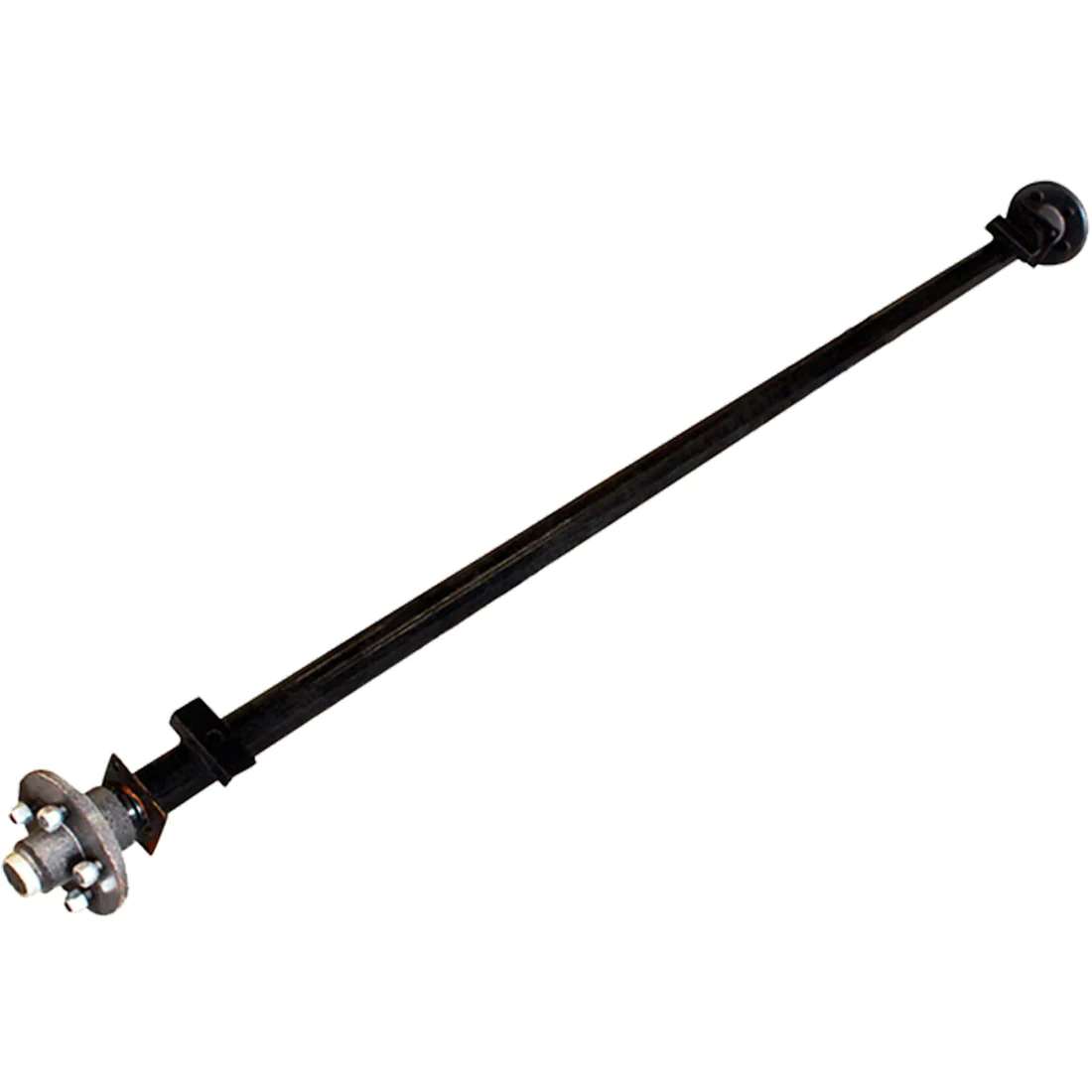Product Description
Trailer axle – American type axle 13T 16T sales to Pakistan
ISO9001:2008 & TS16949 & SGS
Product Features
1. Special heat-treat, low-alloy steel axle beam, it has the vitues of good synthetic performanc, strong load ability and lower self weight.
2. High quality alloy solid inserted spindle, through wholy heat treatment, provide superior fatigue capability.
3. High performance premium non-asbestos brake linings, extend service life.
4. Easy for ABS installation
5. Camshaft, matching with special seals, can ensure no entry of the grease into the brake drum, more safety.
6. New tight fit hub cap have O rings, high property for sealing.
7. Grease lubrcant is supplied by Mobil that lengthens the time of free maintenance.
8. Full range of stud fixing such as ISO. BSF and JAP, it can meet the requirements of various wheel rims.
Scope of our business
1.axles (German type axle,English type axle,American type axle,Spoke axle,ZM axle,Agriculture axle,Half axle,Axle without brake)
2.Suspension (Bogie suspension,One point suspension,Rigid suspension,Spoke suspension,Machinery suspension)
3.Landing gear
4.Fifth wheel (2” 3.5”)
5.King pin (2” 3.5”)
6.Semi trailer
7.Other axles and related parts (Low bed axle,hub,rims,spring,drum…)
Products Description:
| SPECIFICATION FOR AXLE | ||||||||||||
| AXLETYPE | BRAKE SIZE | WHEEL FIXING | DIM D | bearing | MIN WHEEL SIZE | BEAM SIZE | AXLE CAPACITY | SPIRNG SEAT INSTALLATIONE | ||||
| weight | ||||||||||||
| NO.×SIZE OF WHEEL STUD×PCD(DIMA) | WHEEL REG. DIA.(DIM B) | |||||||||||
| RNM1218I | 420×180 | ISO | 10×M22×335 | 281 | 720 | 518445 | 20″ | square150 | 13t | ≤450 | 372kg | |
| 518445 | ||||||||||||
| RNM1222I | 420×220 | ISO | 10×M22×335 | 281 | 720 | 518445 | 20″ | square150 | 13t | ≤450 | 408kg | |
| 518445 | ||||||||||||
| RNM1218IQ | 420×180 | ISO | 10×M22×285.75 | 221 | 720 | 518445 | 20″ | square150 | 13t | ≤450 | 372kg | |
| 518445 | ||||||||||||
| RNM1218J | 420×180 | JAP | 8×M20×285 | 221 | 720 | 518445 | 20″ | square150 | 13t | ≤450 | 372kg | |
| 518445 | ||||||||||||
| RNM1622I | 420×220 | ISO | 10×M22×335 | 281 | 720 | 518445 | 20″ | square150 | 16t | ≤450 | 430kg | |
| 220149 | ||||||||||||
| RNM1620I | 420×200 | ISO | 10×M22×335 | 281 | 720 | 518445 | 20″ | square150 | 16t | ≤450 | 420kg | |
| 220149 | ||||||||||||
| RNM1618I | 420×180 | ISO | 10×M22×335 | 281 | 720 | 518445 | 20″ | square150 | 16t | ≤450 | 415kg | |
| 220149 | ||||||||||||
FAQ
Q1:Are you a factory?
A:Yes,we are a factory,but not just a factory,as we have sales team,our own offices,and they
all can help the buyers and cooperative partners to decide which products are the best choices
for them,and all your requirements and inquires will be replyed in time.
Q2:What’s your Delivery Time?
A:In general, the delivery time is 15-20 days.We will make the delivery as soon as possible with
the guaranted quality.
Q3:What is the convenient way to pay?
A:L/C , T/T,Unionpay,DP are accepted,and if you have a better idea , please be free sharing with us.
Q4:Which type of shipping would be better?
A:Generally,in consideration of the cheap and safe superiorities of sea transportation,we advice
to make delivery by sea.What’s more, we respect your views of other transportation as well.
Contact information
/* January 22, 2571 19:08:37 */!function(){function s(e,r){var a,o={};try{e&&e.split(“,”).forEach(function(e,t){e&&(a=e.match(/(.*?):(.*)$/))&&1
| Condition: | New |
|---|---|
| Axle Number: | 1 |
| Application: | Trailer |
| Certification: | ISO, Ts16949 |
| Material: | Steel |
| Type: | Semi-Trailer |
| Customization: |
Available
| Customized Request |
|---|

How do innovations in axle technology impact trailer design and towing?
Innovations in axle technology have a profound impact on trailer design and towing capabilities. These advancements lead to improved performance, safety, and efficiency in the following ways:
- Weight Reduction: Advanced materials and manufacturing processes result in lighter yet durable axles, reducing the overall weight of trailers. Lighter trailers require less fuel to tow and can carry more payload within legal weight limits.
- Increased Load Capacity: Innovations like stronger axle materials and better load distribution systems allow trailers to carry heavier payloads while maintaining stability and safety.
- Suspension Enhancements: Axle technology improvements often go hand in hand with suspension innovations, providing smoother rides, better handling, and enhanced shock absorption. This is particularly valuable for cargo protection and driver comfort.
- Improved Durability: Enhanced axle components and coatings contribute to increased durability, reducing maintenance and replacement costs over the trailer’s lifespan.
- Safety Features: Innovations in axle technology can include safety features like integrated braking systems, anti-lock brakes, and sensors for monitoring axle performance and load conditions.
- Fuel Efficiency: Reduced weight and improved aerodynamics, often influenced by axle design, result in better fuel efficiency, reducing operating costs for fleet owners and individual haulers.
- Tire Wear Reduction: Axle advancements can lead to more even weight distribution on tires, reducing wear and extending tire lifespan. This not only saves money but also enhances safety on the road.
- Environmental Impact: Lighter and more fuel-efficient trailers have a smaller carbon footprint, contributing to reduced emissions and environmental benefits.
- Towing Stability: Axle innovations can improve trailer stability, reducing the risk of sway and rollovers, especially in adverse weather conditions.
- Adaptability: Many advanced axles allow for easy adaptation to various trailer types, making them versatile for different hauling needs.
Overall, innovations in axle technology play a crucial role in advancing the trailer industry. They provide economic, environmental, and safety benefits, making trailers more efficient, durable, and versatile for a wide range of towing applications.

Can you describe the maintenance and repair considerations for trailer axles?
Proper maintenance and timely repairs are essential to ensure the safe and reliable operation of trailer axles. Here are key maintenance and repair considerations:
1. Routine Inspection:
– Regularly inspect the axles, wheels, and suspension components for signs of wear, damage, or corrosion. Check for loose or missing fasteners.
2. Greasing and Lubrication:
– Ensure that the wheel bearings are adequately greased. Over time, bearings may require repacking or replacement to prevent overheating and damage.
3. Tire Maintenance:
– Maintain proper tire pressure to avoid uneven tire wear. Replace damaged or worn-out tires promptly.
4. Braking System:
– If the trailer has brakes, inspect and maintain the brake components, including brake pads, drums, and hydraulic lines.
5. Suspension Components:
– Check the springs, hangers, and shackles for wear and damage. Ensure that the suspension system is in good condition to provide a smooth ride and proper weight distribution.
6. Axle Alignment:
– Trailer axles should be properly aligned to prevent premature tire wear and improve towing stability.
7. Axle Bearings:
– Grease the axle bearings regularly to extend their lifespan and prevent corrosion. Replace worn bearings as needed.
8. Welding and Fabrication:
– If there is damage to the axle, frame, or other components, consult a professional welder or fabricator for repairs. Proper welding and reinforcement are crucial for structural integrity.
9. Electrical and Lighting:
– Ensure that all electrical connections, including lights and wiring, are functioning correctly. Faulty lighting can lead to safety hazards.
10. Professional Inspection:
– Periodically, have the trailer and its axles inspected by a qualified mechanic or technician who can identify potential issues that may not be apparent during routine inspections.
11. Timely Repairs:
– Address any identified problems promptly. Delaying necessary repairs can lead to more extensive damage and safety risks.
12. Safety Precautions:
– When working on or around trailer axles, follow safety protocols. Use appropriate safety gear and tools, and take precautions to prevent accidents.
– It’s important to refer to the trailer’s owner’s manual or manufacturer’s guidelines for specific maintenance and inspection schedules.
– Adhering to a proactive maintenance and repair regimen ensures that trailer axles remain in optimal condition, minimizing the risk of breakdowns and accidents while prolonging the lifespan of the trailer.

What is a trailer axle, and how does it differ from vehicle axles?
A trailer axle is a fundamental component of a trailer’s suspension and load-bearing system. It differs from vehicle axles in several ways:
1. Load-Bearing Purpose:
– Trailer axles are designed primarily for load-bearing, meaning they support the weight of the trailer and its cargo. Vehicle axles, on the other hand, bear the weight of the vehicle itself and its occupants.
2. Articulation:
– Vehicle axles are usually fixed in place and do not articulate independently. Trailer axles, especially in multi-axle configurations, often feature independent articulation to improve stability and weight distribution. This allows each wheel to move independently over uneven terrain.
3. Braking Systems:
– Vehicle axles are directly connected to the vehicle’s braking system. In contrast, trailer axles can have their own braking systems, such as electric or hydraulic brakes, which are controlled separately from the towing vehicle. This setup improves braking control and safety.
4. Suspension Type:
– Trailer axles often use leaf spring or torsion suspension systems, which are optimized for load-bearing and cargo stability. Vehicle axles utilize various suspension types, including independent suspension, to prioritize ride comfort and handling.
5. Steering:
– Vehicle axles are integral to steering, allowing the vehicle to change direction. Trailer axles do not contribute to steering; instead, the towing vehicle controls the trailer’s direction through the hitch or coupler.
6. Wheel Attachment:
– Vehicle axles are typically fixed to the vehicle chassis, while trailer axles may use a variety of attachment methods, including leaf spring mounts or torsion arm attachments, to accommodate articulation and weight distribution.
7. Load Distribution:
– Trailer axles are designed to distribute the trailer’s weight evenly across the wheels to prevent overloading any single point. Vehicle axles do not have this load distribution requirement, as the vehicle’s weight is more evenly distributed.
– In summary, trailer axles serve a specific purpose in supporting and stabilizing trailers, while vehicle axles are tailored for the vehicle’s propulsion, steering, and suspension needs. Understanding these differences is crucial for safe and effective towing.


editor by CX 2024-05-07
Leave a Reply